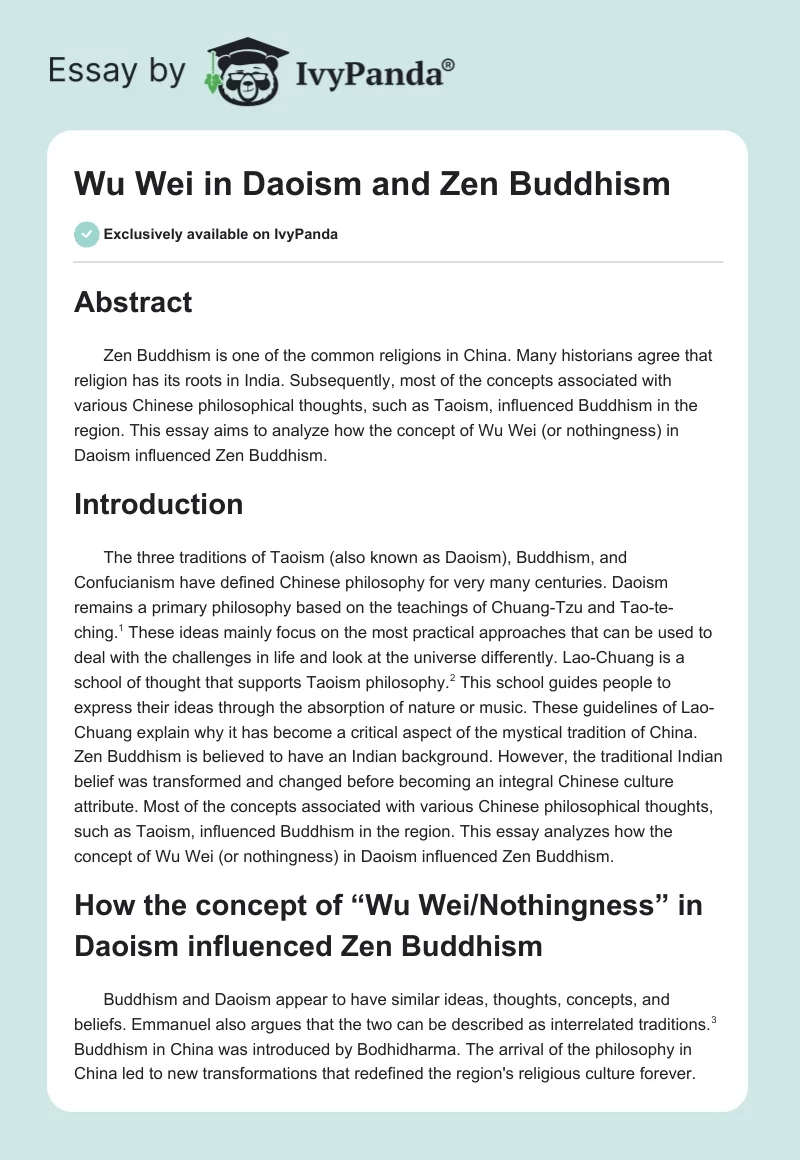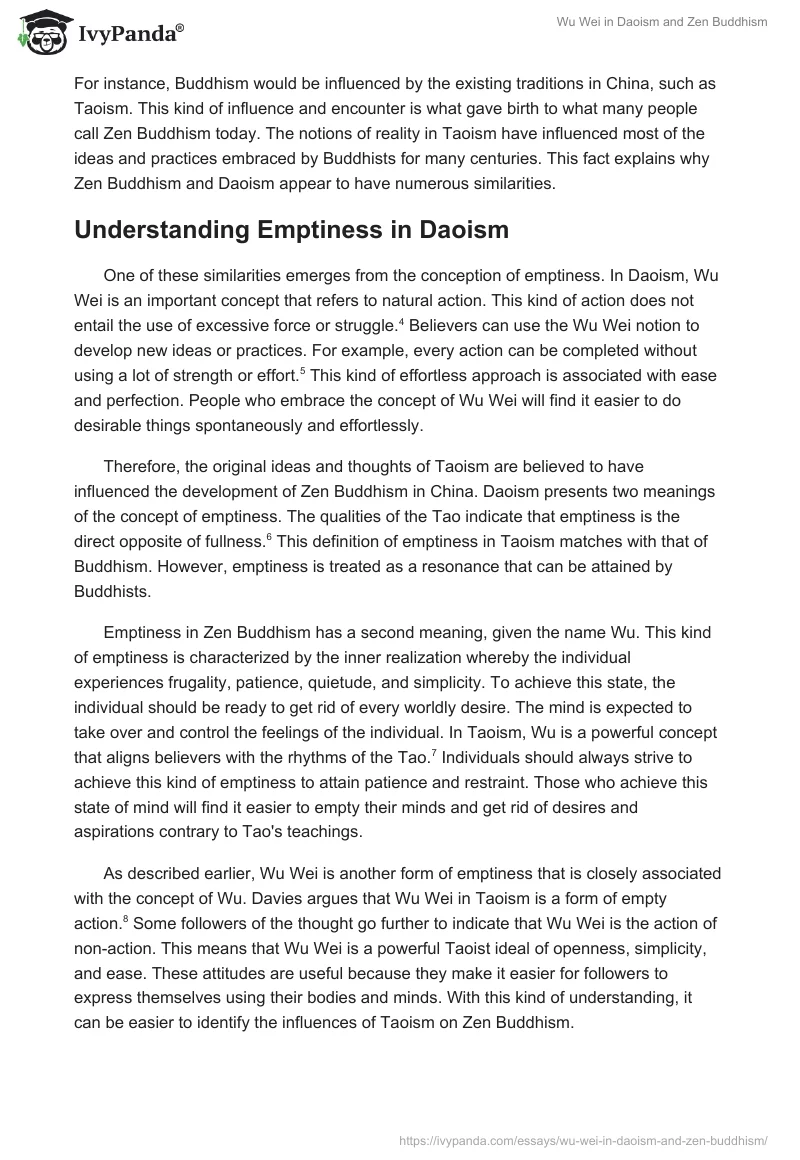Abstract
Zen Buddhism is one of the common religions in China. Many historians agree that religion has its roots in India. Subsequently, most of the concepts associated with various Chinese philosophical thoughts, such as Taoism, influenced Buddhism in the region. This essay aims to analyze how the concept of Wu Wei (or nothingness) in Daoism influenced Zen Buddhism.
Introduction
The three traditions of Taoism (also known as Daoism), Buddhism, and Confucianism have defined Chinese philosophy for very many centuries. Daoism remains a primary philosophy based on the teachings of Chuang-Tzu and Tao-te-ching. These ideas mainly focus on the most practical approaches that can be used to deal with the challenges in life and look at the universe differently. Lao-Chuang is a school of thought that supports Taoism philosophy. This school guides people to express their ideas through the absorption of nature or music. These guidelines of Lao-Chuang explain why it has become a critical aspect of the mystical tradition of China.
Zen Buddhism is believed to have an Indian background. However, the traditional Indian belief was transformed and changed before becoming an integral Chinese culture attribute. Most of the concepts associated with various Chinese philosophical thoughts, such as Taoism, influenced Buddhism in the region. This essay analyzes how the concept of Wu Wei (or nothingness) in Daoism influenced Zen Buddhism.
How the concept of “Wu Wei/Nothingness” in Daoism influenced Zen Buddhism
Buddhism and Daoism appear to have similar ideas, thoughts, concepts, and beliefs. Emmanuel also argues that the two can be described as interrelated traditions. Buddhism in China was introduced by Bodhidharma. The arrival of the philosophy in China led to new transformations that redefined the region’s religious culture forever.
For instance, Buddhism would be influenced by the existing traditions in China, such as Taoism. This kind of influence and encounter is what gave birth to what many people call Zen Buddhism today. The notions of reality in Taoism have influenced most of the ideas and practices embraced by Buddhists for many centuries. This fact explains why Zen Buddhism and Daoism appear to have numerous similarities.
Understanding Emptiness in Daoism
One of these similarities emerges from the conception of emptiness. In Daoism, Wu Wei is an important concept that refers to natural action. This kind of action does not entail the use of excessive force or struggle. Believers can use the Wu Wei notion to develop new ideas or practices. For example, every action can be completed without using a lot of strength or effort. This kind of effortless approach is associated with ease and perfection. People who embrace the concept of Wu Wei will find it easier to do desirable things spontaneously and effortlessly.
Therefore, the original ideas and thoughts of Taoism are believed to have influenced the development of Zen Buddhism in China. Daoism presents two meanings of the concept of emptiness. The qualities of the Tao indicate that emptiness is the direct opposite of fullness. This definition of emptiness in Taoism matches with that of Buddhism. However, emptiness is treated as a resonance that can be attained by Buddhists.
Emptiness in Zen Buddhism has a second meaning, given the name Wu. This kind of emptiness is characterized by the inner realization whereby the individual experiences frugality, patience, quietude, and simplicity. To achieve this state, the individual should be ready to get rid of every worldly desire. The mind is expected to take over and control the feelings of the individual. In Taoism, Wu is a powerful concept that aligns believers with the rhythms of the Tao. Individuals should always strive to achieve this kind of emptiness to attain patience and restraint. Those who achieve this state of mind will find it easier to empty their minds and get rid of desires and aspirations contrary to Tao’s teachings.
As described earlier, Wu Wei is another form of emptiness that is closely associated with the concept of Wu. Davies argues that Wu Wei in Taoism is a form of empty action. Some followers of the thought go further to indicate that Wu Wei is the action of non-action. This means that Wu Wei is a powerful Taoist ideal of openness, simplicity, and ease. These attitudes are useful because they make it easier for followers to express themselves using their bodies and minds. With this kind of understanding, it can be easier to identify the influences of Taoism on Zen Buddhism.
Understanding Emptiness in Zen Buddhism
In modern Zen Buddhism, emptiness is a powerful concept that has been translated by many people as openness or void. The principal terms used to denote emptiness in Buddhism include Kung, Stong-pa-nyid, and Shunyata. The concept goes further to indicate that things of the universe exist as dependent entities. Such entities, according to Zen Buddhism, are causes by infinite conditions.
To perfect wisdom or attain Dharmata, followers should embrace this concept of Shunyata. Dharmata refers to the innate nature of the human mind. This discussion shows clearly that emptiness in Buddhism points to dependent origination as the true nature of phenomena. In Daoism, emptiness or Wu is something that refers to psychological or emotional attitude. It is the state of the human mind that is usually characterized by frugality or simplicity.
From this discussion, it is agreeable that Shunyata in Zen Buddhism is defined as a technical concept. From a Taoist perspective, the idea is expressed implicitly to guide the followers’ worldview and practice. Buddhists agree that every phenomenon is caused by dependent origination. In Taoism, phenomena arise from elemental cycles. Therefore, the two thoughts show conclusively that the human body should be treated as something that connects heaven and the earth.
The concept of Shunyata in Zen Buddhism goes further to produce a quiet state of the human mind. This kind of approach shows conclusively that the concept is consistent with Daoism’s Wu Wei ideals. This is the case because the concepts produce a feeling characterized by simplicity, ease, and flow. The new situation makes it easier for Buddhists and Taoists to relax their minds and get rid of their earthly ideas. The other important thing to note here is that emptiness is defined differently in these two traditions. The exciting part is that the notions take different paths but eventually deliver similar outcomes. It is, therefore, agreeable that all human religions focus on the same knowledge or truth.
Influence of Wu Wei on Zen Buddhism
The above analysis conclusively shows that the perception of emptiness embraced by Zen Buddhists borrows a lot from the ideas and beliefs of Tao. Chinese historians have argued that the encounter of Chuang-Tzu with Buddhism dictated the ideals of the philosophy on different planes such as action, cosmology, and psychology. The emptiness was embraced as a powerful approach whereby human beings forget all attachments. This would be defined as a form of mystical liberation from the challenges of the universe.
Tao-an, one of the earliest Buddhists, decided to ignore his Chinese past and embraced most of the ideas promoted by Taoists. According to Tao-an, it was appropriate to embrace most Chinese classics to lead an admirable and complete life. That being the case, Tao-an’s teachings, such as the “The Original Nature of Dharmas,” gives a complex mixture of Lao-Chuan and Buddhism. This is a clear indication that Zen Buddhism in China has been influenced significantly by the three major philosophies embraced in the region.
Knaul goes further to argue that the concepts of Daoism can be interpreted differently by individuals who want to achieve their goals in life. The conception of Wu Wei (or emptiness) encourages Taoists to use minimal efforts to deal with the challenges affecting them. The school of thought goes further to encourage its followers to avoid being worried or angry. This is the case these emotional responses consume a lot of energy. With the idea of emptiness, the believers can forget the challenges affecting their lives and eventually realize their goals. Many Taoists have embraced this interpretation to overcome the unique challenges associated with human life on earth.
In Buddhism, similar ideas and notions are supported by the perception of emptiness or Shunyata. Zen Buddhism’s Shunyata is a powerful concept that mainly focused on the idea that things are not permanent. Since things are impermanent, the most important thing is for human beings to avoid them. This means that they should not be attached to things that might affect their lives or experiences. When human beings avoid every little thing that affects their lives, they will eventually use their energies wisely. Buddhists will also never waste their energy worrying about the events and things experienced in the universe.
Therefore, it should be observed that the concepts of Wu Wei and Shunyata are tied to one another. The ultimate goal is to use energy wisely and stop worrying about specific things that can affect a person’s life experiences. The two concepts have evolved in such a way that they encourage believers to deal with the issue of permanence. This kind of illusion makes it hard for people to understand that things are not bad or good. Zen Buddhists believe that a bad situation can eventually produce something admirable. That being the case, energy should be used properly to overcome every obstacle or challenge encountered in life.
Taoists have presented numerous concepts that have reshaped the nature of Zen Buddhism in China. Taoists strongly believe that everything in the world has the potential to go to the extreme. To deal with such extremes, Daoism encourages its followers to embrace the best approaches towards establishing a perfect human order. This kind of order can emerge from the concept of nothingness or Wu Wei. Philosophers have argued that the pioneers of the thought were not pessimistic. Instead, they were great thinkers who acknowledged that human actions were limited and could not alter everything in the universe. These notions led to the development of the notion of emptiness in Buddhism.
Therefore, it would be argued that the first Zen Buddhists to land in China found these notions promising. Consequently, they came up with the idea of Shunyata to guide the followers of the belief system. The concept was aimed at guiding more people to avoid specific uncontrollable things or events in the world. The concept has ever since continued to empower many Buddhists in China and across the region. The notions borrowed from the major Chinese philosophies have continued to influence the behaviors of many Zen Buddhists today.
Concluding Remarks
Emptiness is defined differently in Zen Buddhism and Daoism. However, the concept in the two thoughts can be described as the manifestation of the same latent tendency whereby followers search for the best way to lead a free life. This is a clear indication that the concepts in these religions are more or less the same. The outstanding fact is that Zen Buddhism developed the concept of Shunyata after reviewing the major notions and practices embraced by the major Chinese philosophies.
The adequacy of Wu Wei in Daoism made it a unique aspect that could be embraced by the first Buddhists to arrive in China. Therefore, it should be agreed that the concept of Wu Wei in Daoism influenced the development of Zen Buddhism. Consequently, the influence led to the development of the concept of Shunyata that guides people to use their energies wisely in an attempt to realize or attain Dharmata.
Bibliography
Davies, Roger. Japanese Culture: The Religious Philosophical Foundations. North Clarendon: Tuttle Publishing, 2016.
Emmanuel, Stephen. A Companion to Buddhist Philosophy. New York: John Wiley & Sons, 2013.
I-Ying, Yu. Being Formless: A Daoist Movement Practice. Northampton: The University of Northampton, 2015.
Keown, Damien. Buddhist Ethics: A Very Short Introduction. Oxford: Oxford University Press, 2012.
Knaul, Livia. “Chuang-Tzu and the Chinese Ancestry of Ch’an.” Journal of Chinese Philosophy 13, no. 1 (1986): 411-428.
Trungpa, Chogyam. The Path of Individual Liberation. London: Shambhala Publications, 2013.


